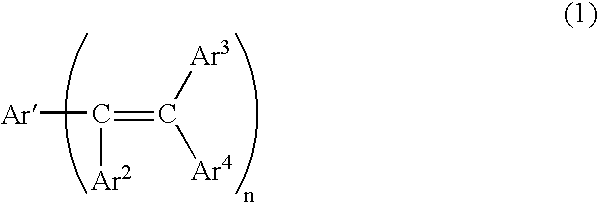Organic electroluminescent device and method of manufacture thereof
a technology of electroluminescent devices and organic light-emitting layers, which is applied in the direction of discharge tube luminescnet screens, natural mineral layered products, transportation and packaging, etc., can solve the problems of increased driving voltage, easy deterioration of organic light-emitting layers, and easy leakage curren
- Summary
- Abstract
- Description
- Claims
- Application Information
AI Technical Summary
Benefits of technology
Problems solved by technology
Method used
Image
Examples
example 1
(1) Preparation for Manufacturing Organic EL Device
Before manufacturing the organic EL device of Example 1, a transparent electrode layer with a thickness of 75 nm was formed from ITO as an anode layer on a transparent glass substrate with a dimension of thickness:1.1 mm.times.length:25 mm.times.width:75 mm. The glass substrate and the anode layer are collectively called a substrate in the following description. This substrate was ultrasonically washed in isopropyl alcohol, dried in a nitrogen gas atmosphere, and washed for 10 minutes using UV (ultraviolet radiation) and ozone.
(2) Formation of Inorganic Thin Layer
Next, the substrate on which an anode layer has been formed was placed in a vacuum vessel for common use as a radio frequency sputtering apparatus and a vacuum deposition apparatus. A target consisting of tin oxide and ruthenium oxide (at a ratio of 10:1) to form an inorganic thin layer was installed in the vacuum vessel. After reducing the pressure in the vacuum vessel to ...
fifth embodiment
The method of the followed in simultaneously depositing vaporized DPVTP and DPAVBi. Specifically, in forming the organic light-emitting layer, the vapor deposition material containers 212B and 212C were respectively arranged at positions at a distance from the rotation axis line of the substrate of 30 mm in the horizontal direction, and the containers were heated in this positional arrangement to simultaneously vaporize DPVTP and DPAVBi, while rotating the substrate around the rotation axis at 5 rpm.
Next, Alq was vaporized from the vapor deposition material containers 212D under the following conditions to form an An electron injection layer on the organic light-emitting layer.
Alq vaporization rate: 0.2 nm / s
Alq thickness: 5 nm
Finally, Al and Li were vaporized respectively from the vapor deposition material containers 212E and 212F to form a cathode layer on the electron injection layer, thereby providing an organic EL device.
Al vaporization rate: 1 nm / s
Li vaporization rate: 0.01 nm / ...
examples 2 to 4
In Examples 2 to 4, organic EL devices were prepared in the same manner as in Example 1, except for changing the types of inorganic compounds and the amounts of the components as shown in Table 3. Luminous brightness and the like were evaluated.
As shown in Table 3, the ionization potential of the inorganic thin layer of each Example was 5.4 eV or more. This is presumed to be due to an intermediate level formed in the inorganic thin layer. The ionization energy of DPVTP which is an organic light-emitting material was 5.9 eV, confirming that the value is greater than the intermediate level (an energy value) of the inorganic thin layer.
PUM
| Property | Measurement | Unit |
|---|---|---|
| Thickness | aaaaa | aaaaa |
| Percent by atom | aaaaa | aaaaa |
| Percent by atom | aaaaa | aaaaa |
Abstract
Description
Claims
Application Information
 Login to View More
Login to View More - R&D
- Intellectual Property
- Life Sciences
- Materials
- Tech Scout
- Unparalleled Data Quality
- Higher Quality Content
- 60% Fewer Hallucinations
Browse by: Latest US Patents, China's latest patents, Technical Efficacy Thesaurus, Application Domain, Technology Topic, Popular Technical Reports.
© 2025 PatSnap. All rights reserved.Legal|Privacy policy|Modern Slavery Act Transparency Statement|Sitemap|About US| Contact US: help@patsnap.com



